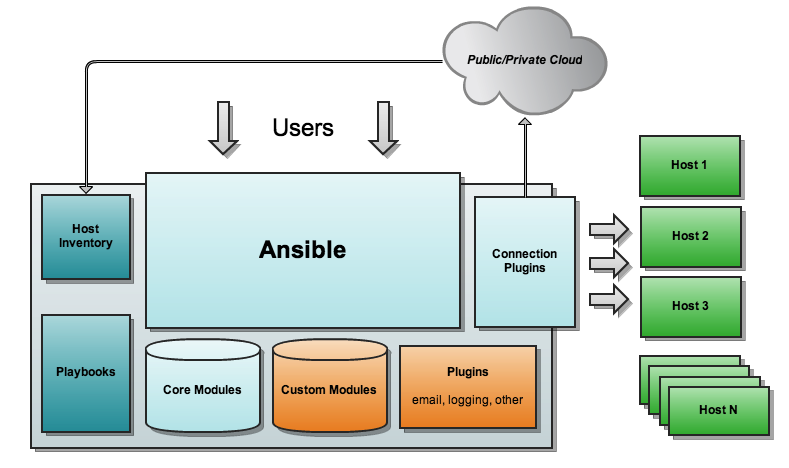ansible入门与实战——配置文件、主机组与模块
简介
“Ansible is Simple IT Automation”——简单的自动化IT工具。这个工具的目标有这么几项:让我们自动化部署APP;自动化管理配置项;自动化的持续交付;自动化的(AWS)云服务管理。1
2#安装
sudo pip install ansible
构成与原理


本质上批量的在远程服务器上执行命令 。
那么fabric和ansible有什么差别呢?简单来说fabric像是一个工具箱,提供了很多好用的工具,用来在Remote执行命令,而Ansible则是提供了一套简单的流程,你要按照它的流程来做,就能轻松完成任务。这就像是库和框架的关系一样。
Asible基本组成 :
- 核心:ansible
- 核心模块(Core Modules):这些都是ansible自带的模块
- 扩展模块(Custom Modules):如果核心模块不足以完成某种功能,可以添加扩展模块
- 主机组(Host Inventory):定义ansible管理的主机
- 插件(Plugins):完成模块功能的补充
- 剧本(Playbooks):ansible的任务配置文件,将多个任务定义在剧本中,由ansible自动执行
- 连接插件(Connectior Plugins):ansible基于连接插件连接到各个主机上,虽然ansible是使用ssh连接到各个
主机的,但是它还支持其他的连接方法,所以需要有连接插件
配置文件
执行命令,ansible会按照如下配置文件位置的顺序,来搜寻配置文件。1
2
3
4* ANSIBLE_CONFIG (环境变量)
* ansible.cfg (当前目录下)
* .ansible.cfg (用户家目录下)
* /etc/ansible/ansible.cfg
主机组
定义ansible管理的主机,/etc/ansible/hosts 文件的格式与windows的ini配置文件类似:
1 | mail.example.com |
- 参数
Inventory 参数的说明
如同前面提到的,通过设置下面的参数,可以控制 ansible 与远程主机的交互方式,其中一些我们已经讲到过:
1 | ansible_ssh_host |
主机文件的例子:
some_host ansible_ssh_port=2222 ansible_ssh_user=manager
aws_host ansible_ssh_private_key_file=/home/example/.ssh/aws.pem
freebsd_host ansible_python_interpreter=/usr/local/bin/python
ruby_module_host ansible_ruby_interpreter=/usr/bin/ruby.1.9.3
模块
模型类型如下:
- Cloud Modules
- Clustering Modules
- Commands Modules
- Crypto Modules
- Database Modules
- Files Modules
- Identity Modules
- Inventory Modules
- Messaging Modules
- Monitoring Modules
- Network Modules
- Notification Modules
- Packaging Modules
- Remote Management Modules
- Source Control Modules
- Storage Modules
- System Modules
- Utilities Modules
- Web Infrastructure Modules
- Windows Modules
Commands 类模块
包含如下子模块:
- command - Executes a command on a remote node
- expect - Executes a command and responds to prompts
- raw - Executes a low-down and dirty SSH command
- script - Runs a local script on a remote node after transferring it
- shell - Execute commands in nodes.
测试raw模块
1 | ansible vps -m raw -a 'echo 1' |
ansible 命令使用
1 | ansible -i 主机组 -m 模块 -a '临时命令' |

